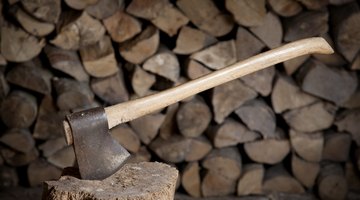What Is the Difference Between a Jersey Axe & a Michigan Axe?
One of the first tools invented by humans was an axe – a tool with a sharp edge that cuts into wood by striking. The addition of a handle added leverage and momentum to axes, and metallurgy allowed people to develop a fine, straight edge with deep penetration.

There has been such a proliferation of axe styles now that one needs a guide to select the best axe for a job.
Single and Double Bits
Jersey and Michigan axes are long-handled axes, with hot-forged steel heads and narrowing slopes, or bits, leading to the sharpened edge, or bevel. The Jersey axe only comes with a single bit, or one blade. The Michigan axe is available as either a single bit or double bit. Double bit axes have two sharpened blades facing in opposite directions. Double-bit axes were designed as felling axes, or axes to cut down trees, and the additional blade could be used without having to resharpen the first.
Handles
Both single-bit axes employ a curved handle, shaped like a stretched S with the long curve, or belly, toward the axe head and the tight curve, or throat, near the free end of the handle. The heads on both the Jersey and Michigan axes weight from 2.5 to 8 pounds, and the curved handles are 3 feet long. The Michigan double-bit axe has a straight handle, also 3 feet long.
Axe Head Anatomy
The axe head anatomy includes: the bit, or bevel leading to the sharpened edge; the bevel, or the angle near the edge that is sharpened; the butt, or back on single-bit axes; the eye, or the hole that the handle inserts into; the cheek, or the unbeveled sides on either side of the handle insertion; and two blade corners, upper and lower, where the blade edge ends. The Michigan and Jersey axes, both wide-bladed axes, differ on the corners and the cheeks.
Cheeks and Corners
The Jersey axe has a cheek that widens downward along the axe handle for greater stability. This widened part of the cheek is called a lug. The Jersey lug is a point facing downward in an obtuse angle. The Michigan axe, both single-bit and double-bit, has a simple cheek without a lug that follows the lines of the bit around the eye. There is a continuous line from the lower corner, past the handle and toward the butt or opposing bit. The Michigan axe head has corners that are rounded; and the Jersey axe has corners that are angled.
The Drip Cap
- One of the first tools invented by humans was an axe – a tool with a sharp edge that cuts into wood by striking.
- The Jersey axe only comes with a single bit, or one blade.
- Both single-bit axes employ a curved handle, shaped like a stretched S with the long curve, or belly, toward the axe head and the tight curve, or throat, near the free end of the handle.
- The Jersey lug is a point facing downward in an obtuse angle.
References
Writer Bio
Stanley Goff began writing in 1995. He has published four books: "Hideous Dream," "Full Spectrum Disorder," "Sex & War" and "Energy War," as well as articles, commentary and monographs online. Goff has a Bachelor of Arts in English from the University of the State of New York.
Photo Credits
- alfernec/iStock/Getty Images
- alfernec/iStock/Getty Images
More Articles



